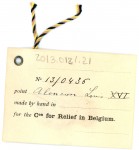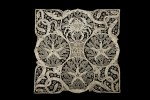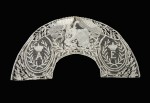 The Smithsonian Institution’s National Museum of American History has a collection of beautiful Belgian laces made during World War I at the behest of future President of the United States Herbert Hoover. Hoover’s name is nowadays most commonly associated with the lack of relief for the destitute of the Great Depression — the notorious tent cities of the homeless and poverty-stricken were famously called Hoovervilles — but before he was president Herbert Hoover was actively involved in relief efforts. As head of the Food Administration under Woodrow Wilson, Hoover was in charge of the administration’s food and fuel conservation programs during the war, but before that, when war first broke out in 1914, Hoover ran the Committee for Relief in Belgium (CRB) which organized the distribution of food supplies to ten million people in occupied Belgium.
The Smithsonian Institution’s National Museum of American History has a collection of beautiful Belgian laces made during World War I at the behest of future President of the United States Herbert Hoover. Hoover’s name is nowadays most commonly associated with the lack of relief for the destitute of the Great Depression — the notorious tent cities of the homeless and poverty-stricken were famously called Hoovervilles — but before he was president Herbert Hoover was actively involved in relief efforts. As head of the Food Administration under Woodrow Wilson, Hoover was in charge of the administration’s food and fuel conservation programs during the war, but before that, when war first broke out in 1914, Hoover ran the Committee for Relief in Belgium (CRB) which organized the distribution of food supplies to ten million people in occupied Belgium.
Hoover wasn’t in government at the time. He wasn’t even in the United States. He was living in London, a wealthy mining engineer and investor who translated Renaissance mining tracts with his wife Lou in his spare time. That translation is considered the standard for its clarity of language and extensive scholarly footnotes and is still in print today. He was drawn into relief work after World War I broke out and tens of thousands of American citizens suddenly found themselves stranded in London. Hoover organized a committee to get them back home and was so effective that in October of 1914 the U.S. ambassador to the Court of St. James asked Hoover to take on a far more onerous job: keep all of Belgium from starving to death.
 Belgium had been invaded by Germany at the start of the war and famine immediately became a very real prospect. The small country only produced enough food to supply 20-25% of the population, but whatever food was available was requisitioned by the occupiers to supply the troops. Britain put Germany and the occupied countries under blockade making food imports nigh on impossible.
Belgium had been invaded by Germany at the start of the war and famine immediately became a very real prospect. The small country only produced enough food to supply 20-25% of the population, but whatever food was available was requisitioned by the occupiers to supply the troops. Britain put Germany and the occupied countries under blockade making food imports nigh on impossible.
That was the Gordian knot Hoover had to cut through. He was able to arrange for the relief supplies to be shipped to Belgium where the CRB monitored their distribution by the Comité National de Secours et d’Alimentation (CNSA), the Belgian organization dedicated to famine relief. The CRB personnel weren’t just passing the time of the day. They had to be involved in every step of the distribution process because as occupied Belgians, CNSA personnel were legally bound to follow German orders. The primarily British and American CRB staff was under no such obligation. Their job was to ensure the food made it to Belgian plates and they did it well. The CRB raised funds, shipped 5.7 million tons of donated food past Germany’s unrestricted U-boat warfare and then literally fed Belgium from 1914 through 1919.
 Hoover’s concern wasn’t just to keep Belgians from mass starvation. He also arranged for thread to be distributed to Belgian lace makers and for the sale of their finished lace to buyers in Allied countries. Belgium had been famous for its delicate handmade laces since the 17th century, and while industrialization and mass-production had hobbled the traditional craft, Queen Elisabeth of Belgium instituted promotional and improvement programs had helped spur a revival of interest in handmade lace just before World War I.
Hoover’s concern wasn’t just to keep Belgians from mass starvation. He also arranged for thread to be distributed to Belgian lace makers and for the sale of their finished lace to buyers in Allied countries. Belgium had been famous for its delicate handmade laces since the 17th century, and while industrialization and mass-production had hobbled the traditional craft, Queen Elisabeth of Belgium instituted promotional and improvement programs had helped spur a revival of interest in handmade lace just before World War I.
The Belgian lace committees worked closely with the “Commission for Relief of Belgium” as the work on behalf of the lace makers became even more important during World War One. Several famous Belgian artists were enlisted to make new designs. Among them were Isidore de Rudder, his sister Maria de Rudder, Charles Michel, and Juliette Wytsman, who designed some of the War Laces that are now part of the collection at the National Museum of American History.
World War One laces often included names of people, places, inscriptions, and dates; a characteristic not usually found in other lace work. The lace often incorporates the coats-of-arms or national symbols of the Allied Nations as well as the nine Belgian provinces in recognition of the help received. It was hoped that these distinguishing elements would appeal to generous people around the world who might buy these laces in support of the Belgian people.
 Sometimes the appeal was even more direct. This exquisite banner panel features a pair of cupids holding a banner inscribed “Augusta-Virginia,” the name of the mother of the Vicomtesse de Beughem. The Vicomtesse, an American married to a Belgian aristocrat, was one of four women in charge of the Lace Committee. It is believed she commissioned the banner in honor of her mother, Augusta Virginia Mitchell. One of the other three women, Mrs. Brand Whitlock, wife of the US ambassador to Belgium, commissioned this table cloth with the seals of the United States, Belgium and the Whitlock family crest.
Sometimes the appeal was even more direct. This exquisite banner panel features a pair of cupids holding a banner inscribed “Augusta-Virginia,” the name of the mother of the Vicomtesse de Beughem. The Vicomtesse, an American married to a Belgian aristocrat, was one of four women in charge of the Lace Committee. It is believed she commissioned the banner in honor of her mother, Augusta Virginia Mitchell. One of the other three women, Mrs. Brand Whitlock, wife of the US ambassador to Belgium, commissioned this table cloth with the seals of the United States, Belgium and the Whitlock family crest.
The program ultimately kept 50,000 lace makers in Belgium working from 1914 through 1919.
 The war laces in the Smithsonian collection are not on public display, but they have been digitized and can be viewed online. It’s a gasp-generating browse, even though I dearly wish the pictures were larger. I know, I know… I always wish the pictures were larger, but the minute details of this lace just beg to be viewed in extreme closeup. It’s a little awkward to navigate, but you can feast your eyes on the minutiae by clicking on the name of the object. This takes you the catalogue entry. Scroll down to the bottom for additional images. Those are detail images, so while you can’t see the whole piece zoomed all the way in to the stitching, you can explore the a section of the lacework in satisfying detail.
The war laces in the Smithsonian collection are not on public display, but they have been digitized and can be viewed online. It’s a gasp-generating browse, even though I dearly wish the pictures were larger. I know, I know… I always wish the pictures were larger, but the minute details of this lace just beg to be viewed in extreme closeup. It’s a little awkward to navigate, but you can feast your eyes on the minutiae by clicking on the name of the object. This takes you the catalogue entry. Scroll down to the bottom for additional images. Those are detail images, so while you can’t see the whole piece zoomed all the way in to the stitching, you can explore the a section of the lacework in satisfying detail.
 One of my favorites is Table Mat With English Scene which has an unbelievable allegorical depiction of the coronation of British King George V in 1911. The image started out as a cartoon by Bernard Partridge published in Punch Magazine which was the converted into lace using the Point de Gaze technique. The Isidore de Rudder Designed Pillow Top goes in a completely different direction, commemorating the battle at the Yzer River with a glorious sea creature design in Point de Venise needle lace. I love the Monogrammed Fan Leaf with Designer’s Name because while it has the monograms of Belgian King Albert I and Queen Elisabeth writ large on either side of the Belgian Lion, it
One of my favorites is Table Mat With English Scene which has an unbelievable allegorical depiction of the coronation of British King George V in 1911. The image started out as a cartoon by Bernard Partridge published in Punch Magazine which was the converted into lace using the Point de Gaze technique. The Isidore de Rudder Designed Pillow Top goes in a completely different direction, commemorating the battle at the Yzer River with a glorious sea creature design in Point de Venise needle lace. I love the Monogrammed Fan Leaf with Designer’s Name because while it has the monograms of Belgian King Albert I and Queen Elisabeth writ large on either side of the Belgian Lion, it  also has the names of designer Juliette Wytsman and the manufacturer Maison Daimeries-Petitjean in very petite cursive under the monogrammed initials. It’s incredible to me that it’s even possible to write your name so small and clear in Point de Gaze needle lace. Oh, and here’s one for Supreme Court Justice Ruth Bader Ginsburg: Collar with Peace Doves.
also has the names of designer Juliette Wytsman and the manufacturer Maison Daimeries-Petitjean in very petite cursive under the monogrammed initials. It’s incredible to me that it’s even possible to write your name so small and clear in Point de Gaze needle lace. Oh, and here’s one for Supreme Court Justice Ruth Bader Ginsburg: Collar with Peace Doves.
I suspect that Hoover may well have been the cleverest of all US presidents. It seems that high IQ is not necessarily much of a help in that job. Nor was his innate decency. He’s been sneered at ever since particularly by people who think highly of much lesser men.
I think Hoover had almost an Enlightment style education, something that otherwise died out with the Founding Fathers. He also wasn’t a career politician, which means he had years to develop his mind and cultivate interests far from the dull roar of politics. He only got into it because his immense gifts for organization floated him to the top like richest cream, but like you say, the presidency seems to have the remarkable ability to hobble gifted people.
Hoover’s important contributions to the Belgian relief efforts are mentioned in Charlotte Kellogg’s book “Bobbins of Belgium,” published in New York by Funk & Wagnall’s in 1920. The book provides a still valuable account of the activities of the Commission for Relief in Belgium, and includes a lucid history of Belgian lacemaking, with technical information, photos and diagrams that can enable interested readers to better understand the textiles marvels in the Smithsonian collection.
Long out of print, the book has been digitized and can be accessed for free at Archive.org.
https://archive.org/stream/bobbinsbelgium00kell#page/n11/mode/thumb
Bookmarked. I’m fascinating by historical crafts and by their intersection with major upheavals like World War I. Thank you for the link. :thanks:
What a wonderful idea. So many people benefitted, and are still benefitting by being able to see these beautiful creations.
An added note; you can expand the photos considerably, and see the detail quite well, although you do lose clear resolution at higher expansions.
That’s the problem; that blurry look drives me crazy. I want them huge and I want them sharp, especially when the details are so significant a part of the work.
I love that you mentioned Justice Ruth Bader Ginsburg in this discussion of lace! I have admired the wonderful collar adornments to her robes very much. (Remember when the Chief Justice added ‘stripes’ to his sleeves?)
I am a huge fan of Justice Ginsburg’s collars. They lend so much individuality to the black robe while still being entirely dignified and elegant. Stripes can’t even begin to compare. Did you see the lace collar that a fan made for RBG? She sent it to her and received a marvelous handwritten thank you note from the Justice. That is die happy territory right there.
Those pieces are wonderful! This is great stuff.
Aren’t they? I love how they combine such a traditional art with current events to make something both timeless and of the moment.
I am so dumb. For real.
:shifty:
I saw the headline and I was puzzled. Why would anyone care about Hoover’s shoestrings? My faith in livius’ seemingly random historical tangents should have never wavered. Of course it was about something far more substantive!
:facepalm:
(Also, if it was about his shoestrings, it would have been interesting.)
:chicken:
That’s not dumb; it’s adorable. I can’t say I intentionally made the title obscure, but I’m very happy you read it that way. New plan: write a post about shoelaces.
Hoover was born in West Bend in eastern Iowa, his Presidential library and museum are there — and his grave. If you are passing by, it is well worth a stop and a couple hours of your time, IMO.
I will absolutely visit the Hoover library and museum if I find myself anywhere near the area. They have a huge collection of stenciled and embroidered flour sacks from the CRB that I would love to see. I’m also fascinated by his work relieving the Soviet famine of 1921.
This was an enlightening lil’ misunderstanding. You read the title with the purest definition of each word. This boo-boo of yours has made my — and probably many more readers here — heart SMILE!
I know I loved it. :boogie:
We have fantastic lace collections here around in Turnhout, native country of the Turnhout Ground paterns. Wished they had contacted us for identifying the different styles. Would definitely have added important data to their collection.By the way: the images are zoomable AND you can drag them around, so you can actually explore the whole pieces.
The catalogue entries have very little information about the lace patterns and styles, you’re right. Most of them limit themselves to describing the designs rather than contextualizing them within the Belgian lace tradition. Oh to be the Smithsonian intern tasked with the job of contacting your experts to learn more about these beautiful pieces.
The images are zoomable, yes, but not to the depth that such intricate, minute work deserves, in my opinion. The detail photographs are better on that score.
I agree with dearieme.
Hoover was a man of many interests as well as being an interesting man. He was the only president who was an employee of the U.S. Geological Survey. The archive of geologic field records I manage preserves his 1894 notebook recording his work in the Sierra Nevada in California under the supervision of the noted geologist Waldemar Lindgren.
I did not know that. It makes sense that as a mining engineer he’d have a keen interest in geology. :thanks:
They still could contact us if they want to; About the zooming: I think it’s a deliberate choice to limit the quality of the pictures shown for two reasons: technically it’s very demanding to keep up streaming images if you want to put online 1000’nds of photos that potentially reach 10.000nds of visitors every day, around the clock. It’s one of the things people don’t understand until they’re confronted with the real cost of it. Every budget has it’s limits, even that of Smithsonian. Second: question of rights management. A handy hacker could easily steal your material, even when streamed, and sell behind your back. This is internet. Don’t fool yourself.
Your blog about the War Laces at the Smithsonian is very interesting. As the volunteer who is responsible for much of the content in the original Smithsonian website article about these laces, I am extremely interested in learning more, so we can add more information. I have tried to contact Cor Vanistendael about the information offered in the answer above about Turnhout, but have not heard back.
I’m so happy you commented! Wonderful work in the original article. I’d love to help you and Cor get in touch. May I email you?
yes
interesting. And it explains that my old-old aunt Palmyre Schepens went to the USA in march 2015 for the CRB and especially for the lace-business. We still have some lace that she gave to my mother.
Many thanks.